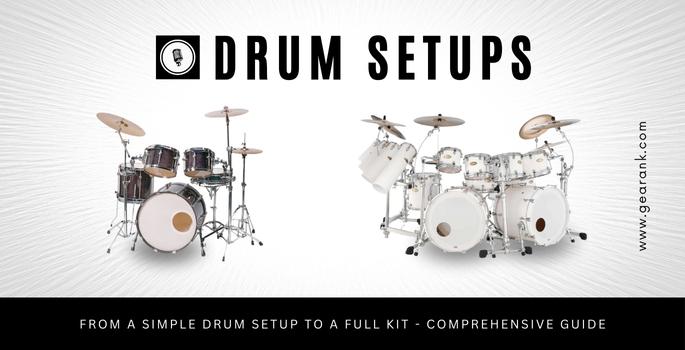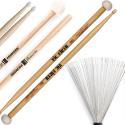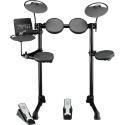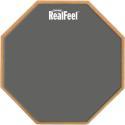Pro Drum Setups

For those new to the world of drumming, there might be a common misconception that there is only one standard way to set up and position a drum kit.
Several drum kit setups are popular among drummers, each with a unique sound and playing style.
These setups can range from the basic four-piece drum kit, consisting of a bass drum, snare drum, hi-hat cymbals, and a ride cymbal, to a more elaborate seven-piece drum kit, which includes additional toms, cymbals, drum hardware, and percussion instruments.
There are also unique arrangements for specific types of drums, like those with double bass drum pedals.
The choice of drum kit setup depends on various factors such as the genre of music, personal preference, and the drummer's skill level.
The Best Drum Setups
A drum kit is a versatile musical instrument that comprises various components, including hi-hats, a hi-hat standard, bass drums, and snare drums.
The configuration of these components varies depending on the drummer's preferred playing style and musical genre.
Here are some of the most common drum set configurations used in the music industry to give you a better idea.
Standard 4-Piece Drum Setup
The 4-piece drum set configuration is popular among drummers specializing in Jazz and rock music genres. This configuration offers quick and easy access to all the gear required for these genres.
The main components of this setup include the bass drum with the bass drum pedal positioned in front of the drummer, the snare drum placed slightly to the left, and the rack tom situated above the bass drum.
Along with these, the hi-hat and the crash cymbal are positioned next to the snare stand, while the floor tom, larger crash cymbal, and the large ride are placed on the right side.
The bass and snare drum are the core pieces of the 4-piece drum setup, but the rack tom and floor tom provide enough tonal variation to play a wide range of songs.
The 4-piece drum kits are also flexible in positioning the ride cymbal as per the drummer's preference.
The 4-piece drum set is compact and more cost-effective than the 5-piece setup, making it an excellent value-for-money option.
Standard 5-Piece Drum Setup
The conventional four-piece drum kit can be upgraded to a five-piece kit by adding an extra rack tom.
Typically, the two rack toms in the five-piece kit are 12" in size, although they can be 13" on rare occasions.
The additional tom provides drummers with a broader range of tonal options.
Placing the rack tom at the center of the kit can cause a problem by requiring the ride cymbal to be positioned further away. Clever rack tom placement solves this, but drummers with short reach might not be able to make the most of the kit.
This could be a significant issue for drummers who rely heavily on the ride cymbal.
5-Piece Drum Kit Configurations With Two Floor Toms
Consider a 5-piece drum with two-floor toms to solve the ride cymbal placement issue. Opt for a 14" floor tom on the left-hand side instead of the crash cymbal, with the crash cymbal next to it.
The second-floor tom should be placed before the first to produce low-end beats and a more robust and enhanced overall sound.
This configuration is quite popular with rock and worship drummers.
The second tom may only sometimes be necessary, especially if space is limited. Take time to determine how best to use the 16" floor tom to maximize your kit's potential.
Standard 6-Piece Drum Setup
The most prevalent drum systems are based on the four-piece kit, which applies to the standard 6-piece configuration.
Pro drummers prefer the extended setup, which includes two racks and two-floor toms, enabling them to play a wide range of sounds.
The tonal variety is significant, thanks to the contrast between the largest floor toms and the smallest rack tom.
This kit is a common choice for metal drummers, and Gospel music players who require fast drum fills with different drums. Additionally, this system is ideal for playing remarkable drum solos.
Symmetrical 6-Piece Drum Setup
The six-piece drum kit with a symmetrical configuration deviates from its predecessor by positioning one of the floor toms on the left side of the hi-hats, along with the hi-hat stand.
This setup offers greater symmetry, which may appeal to a specific group of drummers.
The suitability of this configuration is highly dependent on the user's preferences and dominant hand.
That said, it's worth experimenting with this alternative setup as it allows for more floor tom tuning options and adds versatility to the standard six-piece kit.
7-Piece Drum Setup
The maximum drum configuration recommended for professional use is the seven-piece drum set. This extensive drum kit comprises three different sizes of rack toms, two-floor toms, and an optional China cymbal, making it a complete package.
Metal drummers particularly like this drum set configuration, although it is widely used by drummers playing other music genres as well.
The sheer size of this drum kit, equipped with several cymbals and toms, makes it challenging to transport, especially for frequent gig performers. You'll also have to be well versed at how to mic drums to get a 7 piece miked properly.
Kick Snare Hat
After discussing standard drum configurations, let's now explore some smaller setups. Regarding slimline options, the best setup for drums is one that includes only hi-hats with a hi-hat stand, a snare drum, and a kick drum.
Even though this kit lacks the rack toms and crash cymbals, it can still play simple grooves, and the hi-hats provide enough avenues for expression. Embracing minimalism is a great way to stimulate creativity, which is why the kick snare hi-hat kit is a popular choice among spontaneous drummers performing at bars and clubs.
3-Piece Drum Setup
Try out the three-piece configuration for those who prefer a bit more complexity in their drum setup.
This setup provides a similar layout to the hi-hat snare setup but with the addition of a floor tom. Combining the lower-pitched drum and the tom produces a unique and desirable sound.
This particular setup is favored by many Jazz drummers and Indie rock musicians due to its ability to add character to their playing.
How To Choose The Right Drum Kit Setup
Proper positioning of the drum kit is just as important as having the right gear. The position of your hi-hat pedal, floor tom legs, and cymbal stands all take up space.
Apart from the size of your drum kit setup, you also need to consider the sound. Each setup option offers different sounds for various playing styles and techniques.
Here are some things I found helpful in setting up my drum arrangement.
Remember Ergonomics And Techniques
Before diving into the nitty-gritty of sound production and placement, ensuring that your kit setup is optimized for playability is essential.
When positioning your hi-hat stand, cymbal stand, and other gear, consider how easy it is to reach your side snare and quickly hit the drums for fast-paced pieces.
The placement of your equipment will also depend on your playing experience, technique, and style.
As a general guideline, keep your snares and kick components within comfortable reach, as these are the pieces you'll utilize the most.
Height and size also play an important role, which is why the best beginner drum set for adults are different the best kids drum set. This principle also applies when using a practice pad, consider its height and ergonomics to make the most out of your best drum practice pad.
Speaking of height, you need to have a comfortable drum throne at just the right height. If you're looking for one, check out our guide on the best drum thrones.
Angle Your Drum Components
Once you have acquired a drum setup, the next step is to make meticulous adjustments to your gear. It is crucial to ensure that the angle of your toms is equivalent to that of the snares.
Considering that most drummers initiate playing with a snare drum hand technique, it is practical to replicate this hand technique for the toms.
Try Air Drumming
During my drum kit setup, I prefer air drumming with my drum sticks to assess the placement and positioning of critical components essential to my playing style. Different drum stick sizes can impact playing for better or for worse, so make sure that you have accecs to a different model.
Switch Regularly
As a seasoned drummer, I recognized the need to refresh my musical approach after years of playing with the same setup.
Through prolonged use of any instrument, it is natural for suboptimal techniques to develop, and for a drummer, this can lead to stagnation in playing style and repertoire. I sought to modify my drum kit's configuration to reinvigorate my creativity.
Similar to environmental changes that can inspire and relax us, adjusting the drum kit's setup can provide new musical perspectives for drummers.
Even playing the same tunes can sound distinct when the kit is configured differently, as the sound waves travel alternate paths and create unique soundscapes.
Another legit way of going beyond the usual drumming is to incorporate electronic drums into your drum setup. Using a double pedal is also fun if you're into genres that require them.
Final Thoughts
When it comes to drum setups, a wide range of options are available, from the traditional four-piece setup, consisting of a hi-hat, bass drum, snare, toms, and cymbals, to larger and more complex configurations.
I suggest experimenting with different setups to find what works best for your music and playing style. It is important to remember that every drummer needs to change things up occasionally to keep their music fresh. So, don't be afraid to try out new configurations that can inspire new ideas and creativity.
Contributors:
- Jerry Borillo - Illustrator












